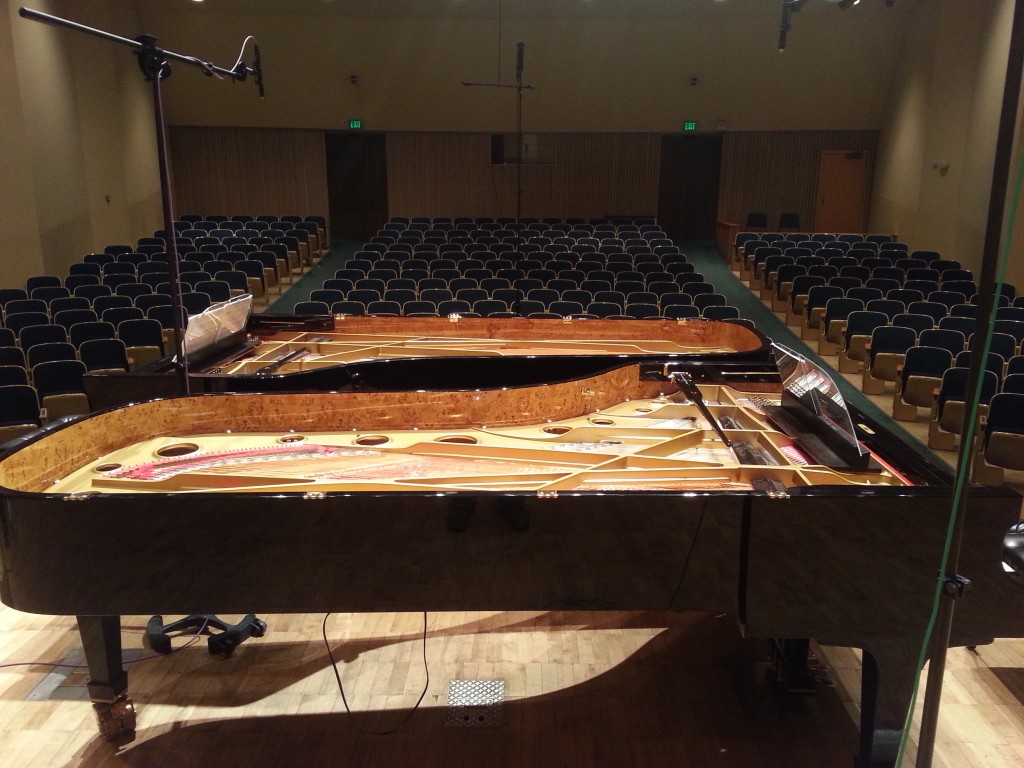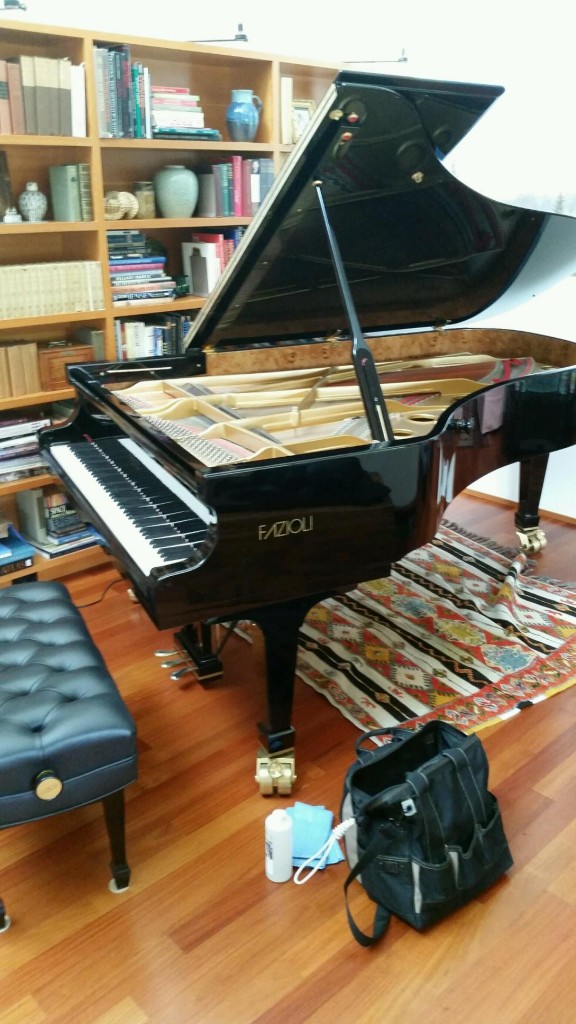Piano tuning is the act of making minute adjustments to the tensions of the strings of an acoustic piano to properly align the intervals between their tones so that the instrument is in tune.
I offer full service tuning including minor repairs, such as fixing a broken string or hammer, cleaning the soundboard, refining the action regulation (touch), or voicing (tone quality). Tunings are approximately one and a half to two hours long.
Call 208-798-9703 >

Prepping Fazioli concert grands for a two piano recording in Kimbrough Hall, School of Music, Washington State University.

Servicing a client's piano.
Piano Tuning
Your piano may benefit from voicing if:
- Your piano sounds different than when you purchased it.
- You don’t like the sound even after it has been tuned.
- Tone varies radically from note to note.
- You cannot achieve a range of tone (mellow to bright) at different volumes.
- The piano has lost its ability to play softly.
Before deciding if a new piano needs voicing, make sure it is well-tuned and well-regulated. Then, play a wide variety of music on it. Most voicing procedures are long-lasting, so give yourself some time to explore the sound of a new instrument before deciding to change it.
How often voicing is needed depends upon the piano’s usage and its intended audience. Pianos in concert halls and recording studios often receive minor refinement of the voicing before each performance. A home piano may need some initial voicing to customize it to the owner’s taste, then once every one to five years to maintain its tone.
Your piano and your musical needs are unique – your own schedule for periodic voicing is a matter for you and your technician to decide. To find out how voicing might improve the tone of your piano, ask for a demonstration on one or two notes.
One of your piano’s most important assets is its tone. Properly voiced, your piano can offer you a rich palette of music expression, and inspire good practice habits in every member of your family. However, piano owners are not always aware that tone can be customized to their own tastes and room acoustics, and to correct for deterioration and age. If the only service your piano has received is tuning, the sound can likely be improved by voicing.
Before you or your technician can fully evaluate then tone of your piano, it must be well-tuned. Tuning is the first step in improving the sound of any piano and may actually provide the tone you desire. If the tone is still not satisfactory. Your technician will inspect the action, hammers and strings. If these components are severely worn, major repairs may be required before an improved tone is possible.
Moderately worn hammers can be re-shaped with sandpaper to remove string grooves and restore their original rounded shape. Next, the hammers are aligned to strike each string squarely.
Action regulation should be checked or adjusted. This ensures an even, powerful response from each key.
If tuning, hammer shaping and regulation are correct, the tone probably will be balanced but still may be too bright or mellow for your taste. If so, your technician might recommend voicing the hammers.
For a tone that is too loud, too bright or seems to die out too quickly, softening the hammers felt often is recommended. This is usually done by inserting needles into specific areas of the hammer to increase flexibility.
For a tone that is too weak or too mellow, hardening of the hammer felt may be necessary. This is usually done by filing away soft outer layers of hammer felt or by applying a chemical hardening solution.
Once the overall tone is correct, individual notes are voiced to make the tone as even as possible from one end of the keyboard to the other. In some pianos certain notes still may sound different from their neighbors, no matter how skillfully the technician voiced the piano. This most commonly occurs about an octave below middle C, where the strings change from steel wires wrapped with copper to plain steel. Such irregularities are a result of design compromises, and usually cannot be corrected by voicing.
Just when a pitch raise or lowering is necessary depends upon how accurate the final tuning must be, and the size and quality of the piano. Any net change in a piano’s string tension during tuning will distort the final result and reduce stability. Realistically, a pitch difference of a few percent can usually be accommodated successfully during tuning. For average situations, when a piano’s pitch is noticeably different from that of other standard pitched instruments, a pitch correction procedure is necessary before tuning. Whenever exact pitch level is critical, such as in concert or recording instruments, any pitch deviation must be corrected before tuning.
Your piano is designed to sound its best when tuned to A-440 (A above middle C vibrates at 440 cycles per second), the international pitch standard. At this pitch, power and tonal range are optimum and your piano will match the pitch of other instruments. When your piano varies from A-440, pitch adjustments are required to bring it back to standard. By always maintaining your piano at standard pitch, you create long-term tuning stability because the strings and structure stay in equilibrium. You also ensure proper ear training because you always hear your music in the correct key.
A pitch raise is essentially a special tuning procedure designed to leave the piano approximately in tune. For moderate pitch corrections the procedure takes about the same time as a tuning, or less. Extreme pitch changes may require two separate pitch adjustments.
The pitch adjustment and subsequent tuning may be done in one visit, or the tuning may be scheduled for a short time later depending upon how far the pitch had to be changed. In general, the longer a piano has gone without regular service, the more tunings will be required to reestablish tuning stability.
Like your car, your piano is a major investment which deserves regular servicing to keep it working well and preserve its value. Most importantly, the well-maintained piano sounds better, plays better, and gives you and your family a wealth of musical pleasure.
Tone varies, even among pianos of the same make and model. No matter what its size or cost, any good piano should provide a wide range of tone, from soft and sweet to loud and bright. The tone should be even from the lowest to the highest notes. Most of all, it should sound musical.
What does the perfect piano tone sound like? There is no single answer, because everyone’s taste varies. Also, certain tonal characteristics are more suited to specific styles of music. A bright, lively tone might be best for jazz, whereas you might prefer a rich and dark sound for Beethoven’s music. There are many different sizes and models of piano available in the market place; you chose your piano because it sounded good to you.
But a piano’s tone changes with use. As the hammers wear and compact, the tone often becomes too bright and harsh, robbing the pianist of the ability to produce a sweet sound. As parts wear, the regulation (adjustment of the mechanical parts that transmit motion from the fingers to the hammers) becomes uneven, and the pianist loses control over volume and tone. This is most noticeable in quiet playing. A delicate pianissimo passage becomes very difficult or impossible to play, and some keys may not sound at all if played very lightly.
Aging of the piano’s strings and structure also can diminish its tone.
Other factors that affect the sound you hear from your piano are:
- Room Acoustics: Hard shiny surfaces such as windows and bare floors reflect high frequencies, making a piano sound bright and loud. High ceilings or large adjoining rooms add resonance. Rugs and upholstered furniture soften tone and add warmth.
- The Lid: Both grands and verticals sound louder and brighter if the lid is opened.
- You: Your ears are sensitive, and will perceive sound differently if you have spent all day in a quiet office or at a loud construction site.
Every piano is different but the cost is essentially between $175-$200 depending on your location and the amount of work required.
Every piano has its own unique sound. One might be described as ‘glassy,’ another as ‘warm’. One might have a ‘full singing’ tone, and yet another sounds ‘thin.’ Although the original design establishes the basic character of your piano’s tone, your technician can modify it to better suit your taste or restore its original tone if it has deteriorated with age. The process of modifying a piano’s tone is called voicing.
Tuning is the adjustment of the tension of all of your piano’s 220 (or more) strings to the correct pitch or frequency. This ensures that notes played in a musical interval (octaves, chords, etc.) will sound in harmony.
Voicing is the adjustment of a piano’s tone or quality of sound. Tone can be changed without affecting the pitch. For example, turning the bass or treble knobs on your stereo changes the tone but does not alter the notes the musician recorded. A skilled piano technician can voice a piano to change its tonal personality from mellow to bright or robust to delicate. The degree of change possible depends upon the piano’s design and condition.
Piano strings change pitch for two primary reasons: the initial stretching and settling of strings when the piano is new, and soundboard movement due to humidity variation. In the case of new pianos, the pitch drops quickly for the first couple of years as the new strings stretch and wood parts settle. It’s very important to maintain any new piano at the proper pitch during this period, so the string tension and piano structure can reach a stable equilibrium. (Most piano manufacturers recommend three to four tunings the first year, and at least two per year after that.)
Aside from this initial settling, climate change is the main cause of pitch change. That’s because the piano’s main acoustical structure — the soundboard — is made of wood. While wooden soundboards produce a wonderful sound, they also react constantly to climate changes. As the relative humidity goes up, the soundboard swells, increasing its crowned shape and stretching the piano’s strings to a higher pitch. Then during dry times the soundboard flattens out, lowering tension on the strings and causing the pitch to drop. The drop in the dry season tends to exceed the rise during humid times, so the net result is a drop in pitch each year that the piano isn’t serviced.
If a piano has gone without tuning for an extended period, its pitch may have dropped far below A- 440. This means that each of its approximately 220 strings needs to be tightened considerably, adding tremendous additional tension to the piano’s structure. The problem is that as each string is tightened, the additional load causes the pitch of previously adjusted strings to change. Thus it is impossible to make a substantial change in pitch and end up with a fine, accurate tuning in one step. Instead, a process called “pitch raising” must first be done, in which all strings are raised to their correct average tension levels. (Likewise, when a piano’s pitch is higher than standard, a pitch lowering procedure must be done to reduce string tensions to approximately correct levels.) Only then can the piano be accurately tuned. In other words, accurate tuning is only possible when all strings are so close to their proper tension that only small further changes are needed during tuning. These small changes then do not disturb the tuning of other strings.
